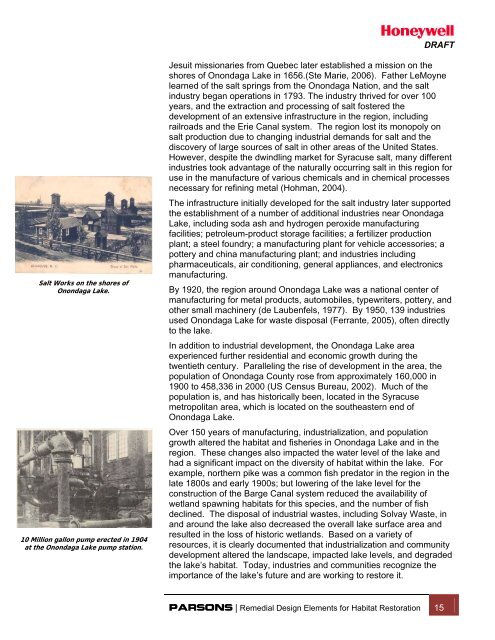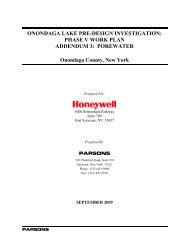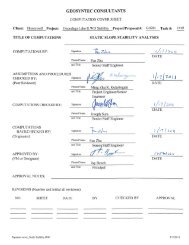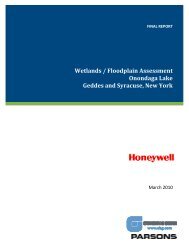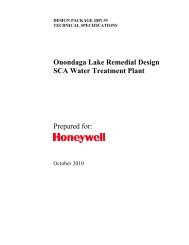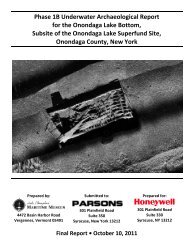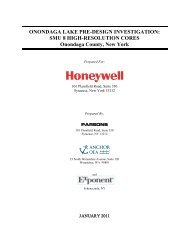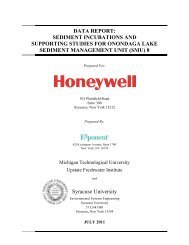Onondaga Lake Remedial Design Elements Remedial Design ...
Onondaga Lake Remedial Design Elements Remedial Design ...
Onondaga Lake Remedial Design Elements Remedial Design ...
- No tags were found...
You also want an ePaper? Increase the reach of your titles
YUMPU automatically turns print PDFs into web optimized ePapers that Google loves.
DRAFTSalt Works on the shores of<strong>Onondaga</strong> <strong>Lake</strong>.10 Million gallon pump erected in 1904at the <strong>Onondaga</strong> <strong>Lake</strong> pump station.Jesuit missionaries from Quebec later established a mission on theshores of <strong>Onondaga</strong> <strong>Lake</strong> in 1656.(Ste Marie, 2006). Father LeMoynelearned of the salt springs from the <strong>Onondaga</strong> Nation, and the saltindustry began operations in 1793. The industry thrived for over 100years, and the extraction and processing of salt fostered thedevelopment of an extensive infrastructure in the region, includingrailroads and the Erie Canal system. The region lost its monopoly onsalt production due to changing industrial demands for salt and thediscovery of large sources of salt in other areas of the United States.However, despite the dwindling market for Syracuse salt, many differentindustries took advantage of the naturally occurring salt in this region foruse in the manufacture of various chemicals and in chemical processesnecessary for refining metal (Hohman, 2004).The infrastructure initially developed for the salt industry later supportedthe establishment of a number of additional industries near <strong>Onondaga</strong><strong>Lake</strong>, including soda ash and hydrogen peroxide manufacturingfacilities; petroleum-product storage facilities; a fertilizer productionplant; a steel foundry; a manufacturing plant for vehicle accessories; apottery and china manufacturing plant; and industries includingpharmaceuticals, air conditioning, general appliances, and electronicsmanufacturing.By 1920, the region around <strong>Onondaga</strong> <strong>Lake</strong> was a national center ofmanufacturing for metal products, automobiles, typewriters, pottery, andother small machinery (de Laubenfels, 1977). By 1950, 139 industriesused <strong>Onondaga</strong> <strong>Lake</strong> for waste disposal (Ferrante, 2005), often directlyto the lake.In addition to industrial development, the <strong>Onondaga</strong> <strong>Lake</strong> areaexperienced further residential and economic growth during thetwentieth century. Paralleling the rise of development in the area, thepopulation of <strong>Onondaga</strong> County rose from approximately 160,000 in1900 to 458,336 in 2000 (US Census Bureau, 2002). Much of thepopulation is, and has historically been, located in the Syracusemetropolitan area, which is located on the southeastern end of<strong>Onondaga</strong> <strong>Lake</strong>.Over 150 years of manufacturing, industrialization, and populationgrowth altered the habitat and fisheries in <strong>Onondaga</strong> <strong>Lake</strong> and in theregion. These changes also impacted the water level of the lake andhad a significant impact on the diversity of habitat within the lake. Forexample, northern pike was a common fish predator in the region in thelate 1800s and early 1900s; but lowering of the lake level for theconstruction of the Barge Canal system reduced the availability ofwetland spawning habitats for this species, and the number of fishdeclined. The disposal of industrial wastes, including Solvay Waste, inand around the lake also decreased the overall lake surface area andresulted in the loss of historic wetlands. Based on a variety ofresources, it is clearly documented that industrialization and communitydevelopment altered the landscape, impacted lake levels, and degradedthe lake’s habitat. Today, industries and communities recognize theimportance of the lake’s future and are working to restore it.PARSONS | <strong>Remedial</strong> <strong>Design</strong> <strong>Elements</strong> for Habitat Restoration 15


